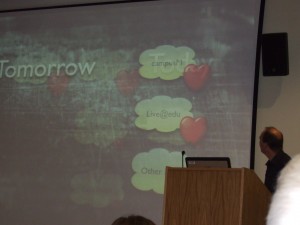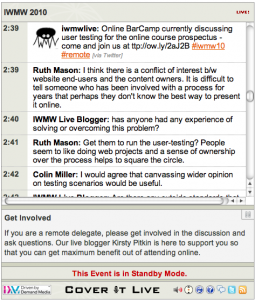Lynda Bewley gives us her summary of the parallel session “Usability and User Experience on a Shoestring” presented by Stuart Church…
____________
This parallel session explored ways in which user experience methods could be made more cost-effective yet still provide tangible benefits.
Stuart started by asking the 18 delegates around the table for real-life examples of situations in which guerrilla usability testing methods would help their work. Common issues arising were that many web projects tended to be deadline-driven, leaving little time for user testing; usability decisions tended to be based on the knowledge of internal ‘experts,’ without any reference to a strong external evidence base. Some delegates found that design decisions were dictated by marketing teams as the ‘gatekeepers’ of the university’s external profile.
Stuart outlined some ways to adopt a more user-centred philosophy within an organisation, which included:
1. User-Centred Design (UCD), which involves:
- Understanding the business and organisation
- Understanding the context of use – what are the success metrics of the site?
- Designing on the basis of this knowledge
- Evaluating the design
- Modifying based on evaluation/repeating the process
2. Behaviour first. Design second. If you understand people then design will naturally fall out of that. If you start with the technology then your site will be not be usable. This approach is ‘outside-in, not inside-out.’
3. ‘The user is always right’, by Steve Mulder outlines the following five ideas:
- What are the business results for making your users happy?
- You are not your users
- Learn about your users by interacting with them
- Make the findings of your research understandable and actionable
- Design your site based on this knowledge
4. ‘Emotional Design’ by Don Norman says that design is ‘Visceral’, ‘Behavioural’ and ‘Reflective’.
5. ‘Rework’ by 37 signals. This book recommends creating a clear epicentre for design.
- Design the right thing
- Avoid feature creep
- Create a clear epicentre for design
- Focus on simplicity
- Deliver better return on investment
Stuart went on to outline some low-cost ‘guerrilla’ methods for user research and evaluation, which included:
1. Usabilla: online ‘Micro usability tests’; low cost (free-$950); useful for preference and attitude testing, and analysis of simple tasks. Tests are based on screenshots and outputs include heat map overlays. Stuart performed a live demo which proved that setup time was less than 15 minutes.
2. Loop11: remote task-oriented testing that runs on your live site. User self-reports on any difficulties they experience.
3. Google Website Optimizer: A/B and multivariate testing that is free, simple and powerful; used to run ‘experiments’ to test specific hypotheses about designs. Requires well-defined goals/conversions; goes one step beyond analytics.
4. Bipolar Emotional Response Tests (BERTS) or ‘semantic differential method’: using a grid of ‘descriptors’ which users mark up to generate a quantifiable ‘emotional fingerprint’ of your site. Useful for benchmarking user perceptions against how stakeholders want a site to be perceived.
5. System Usability Scale (SUS): a method of fast data collection, simple analysis, robust method, produces an overall score out of 100 for your site, useful for benchmarking.
6. Websort: an online card sorting tool, $79 per study, used to inform or validate information architecture of site. This remote method is very useful for getting high numbers of responses and therefore meaningful results. Can be used with an ‘open sort’ (no pre-defined categories) or a ‘closed sort’ where the categories are already defined.
7. Skype: a free, large user base, great for remote research, audio/video and screen sharing.
8. Ethnio: a user recruitment and management tool for setting up remote panels, $400 for the first 200 users, built-in screener. It can appear on your site as a pop-up or a direct link.


